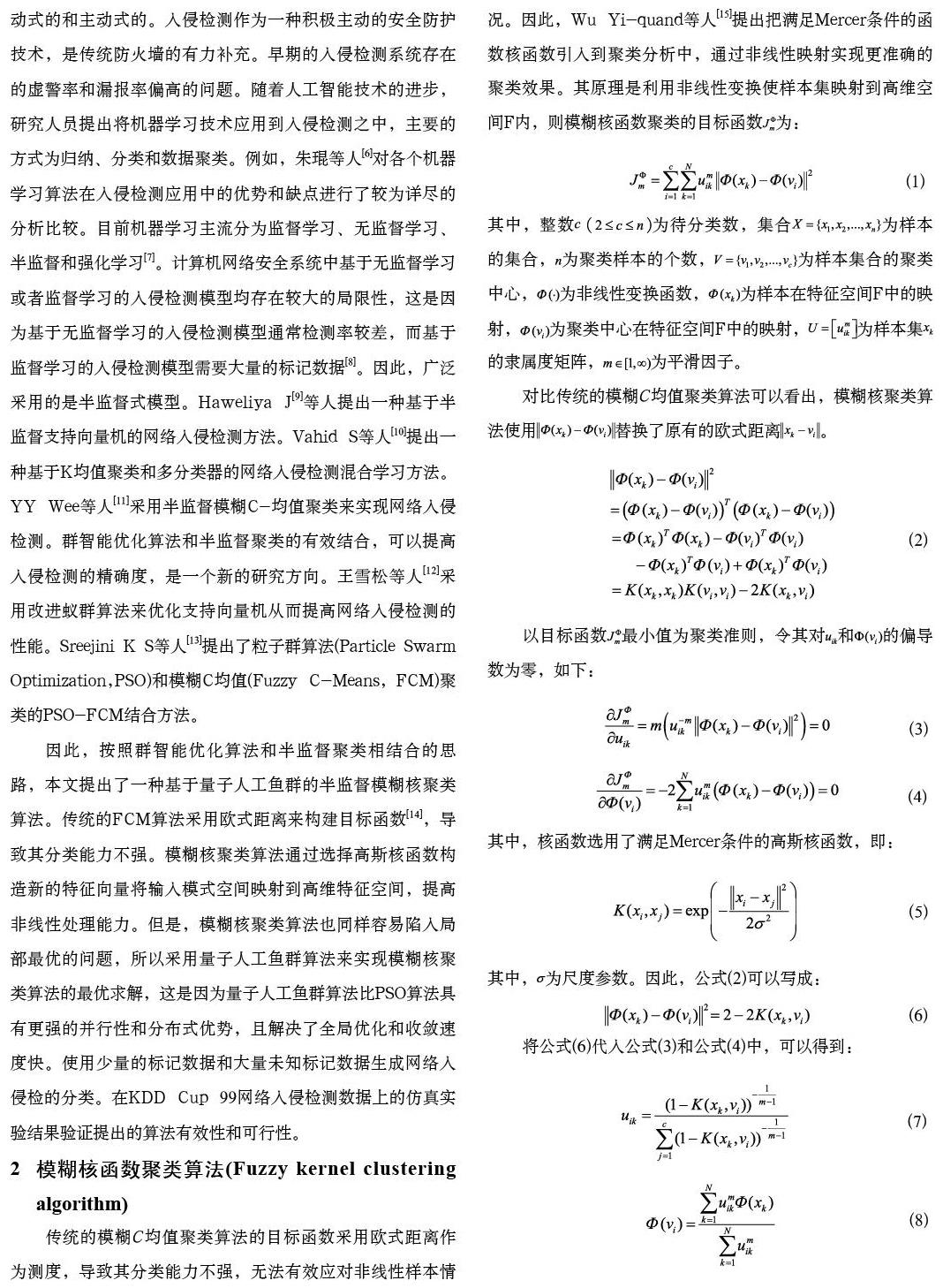基于量子人工鱼群和模糊核聚类算法的网络入侵检测模型研究
2019-07-18李根
李根



摘 要:针对基于传统模糊C均值聚类的网络入侵检测模型存在分类效果不佳,且容易出现局部极值的问题,提出了一种基于量子人工鱼群的半监督模糊核聚类算法。该算法使用少量的标记数据和大量未知标记数据生成网络入侵检的分类,并通过核距离的方式构建了模糊C均值聚类算法的新目标函数,此外,结合了量子人工鱼群算法来解决模糊核聚类算法的全局最优解问题,适用于并行执行架构。在KDD Cup 99网络入侵检测数据上的仿真实验结果表明,相比于基于FCM和PSO-FCM的入侵检测模型,以及基于此提出的算法入侵检测模型具有更好的检测率。
关键词:网络安全;入侵检测;量子人工鱼群;半监督学习;C均值聚类
中图分类号:TP393.8 文献标识码:A
Abstract:Aiming at the problem that the network intrusion detection model based on traditional fuzzy C-means clustering has poor classification effect and the local extremum is easy to occur,the paper proposes a semi-supervised fuzzy kernel clustering algorithm based on quantum artificial fish school optimization.The algorithm uses a small amount of tag data and a large amount of unknown tag data to generate the classification of network intrusion detection,and constructs a new objective function of fuzzy C-means clustering algorithm by means of kernel distance.In addition,it is combined with quantum artificial fish school optimization algorithm to solve the global optimal problem of the fuzzy kernel clustering algorithm,which is applicable to the parallel execution architecture.The simulation results on the KDD Cup 99 network intrusion detection data show that the intrusion detection model based on the proposed algorithm has better detection rate than that based on FCM and PSO-FCM.
Keywords:network security;intrusion detection;quantum artificial fish school;semi-supervised learning;C-means clustering
1 引言(Introduction)
伴随着互联网技术的不断普及,网络支付和网购等的得带了飞速的发展,个人、企业和政府部门对网络的依赖性已经越来越高,网络安全的重要性问题也是日益突出。但是,网络的安全问题其实涉及很多方面,且由于先天性发展问题,安全漏洞在网络协议中无处不在,导致黑客入侵事件和计算机病毒的泛滥[1-3]。如果不能有效遏制这种现象,将会给整个国家乃至整个社会带来巨大的灾难。因此,网络安全问题己成为世界各界十分最关注的问题之一。
现阶段的网络安全防护技术大致可以分为两种[4,5]:被动式的和主动式的。入侵检测作为一种积极主动的安全防护技术,是传统防火墙的有力补充。早期的入侵检测系统存在的虚警率和漏报率偏高的问题。随着人工智能技术的进步,研究人员提出将机器学习技术应用到入侵检测之中,主要的方式为归纳、分类和数据聚类。例如,朱琨等人[6]对各个机器学习算法在入侵检测应用中的优势和缺点进行了较为详尽的分析比较。目前机器学习主流分为监督学习、无监督学习、半监督和强化学习[7]。计算机网络安全系统中基于无监督学习或者监督学习的入侵检测模型均存在较大的局限性,这是因为基于无监督学习的入侵检测模型通常检测率较差,而基于监督学习的入侵检测模型需要大量的标记数据[8]。因此,广泛采用的是半监督式模型。Haweliya J[9]等人提出一种基于半监督支持向量机的网络入侵检测方法。Vahid S等人[10]提出一种基于K均值聚类和多分类器的网络入侵检测混合学习方法。YY Wee等人[11]采用半监督模糊C-均值聚类来实现网络入侵检测。群智能优化算法和半监督聚类的有效结合,可以提高入侵检测的精确度,是一个新的研究方向。王雪松等人[12]采用改进蚁群算法来优化支持向量机从而提高网络入侵检测的性能。Sreejini K S等人[13]提出了粒子群算法(Particle Swarm Optimization,PSO)和模糊C均值(Fuzzy C-Means,FCM)聚類的PSO-FCM结合方法。
因此,按照群智能优化算法和半监督聚类相结合的思路,本文提出了一种基于量子人工鱼群的半监督模糊核聚类算法。传统的FCM算法采用欧式距离来构建目标函数[14],导致其分类能力不强。模糊核聚类算法通过选择高斯核函数构造新的特征向量将输入模式空间映射到高维特征空间,提高非线性处理能力。但是,模糊核聚类算法也同样容易陷入局部最优的问题,所以采用量子人工鱼群算法来实现模糊核聚类算法的最优求解,这是因为量子人工鱼群算法比PSO算法具有更强的并行性和分布式优势,且解决了全局优化和收敛速度快。使用少量的标记数据和大量未知标记数据生成网络入侵检的分类。在KDD Cup 99网络入侵检测数据上的仿真实验结果验证提出的算法有效性和可行性。
2 模糊核函数聚类算法(Fuzzy kernel clustering algorithm)
6 结论(Conclusion)
本文提出了一种基于量子人工鱼群的半监督模糊核聚类算法,将群智能优化算法和半监督聚类有效结合到一起。通过选择高斯核函数构造新的目标函数,解决了传统的FCM算法分类能力不强和非线性处理的问题。此外,采用量子人工鱼群算法来实现模糊核聚类算法的最优求解,解决了容易陷入局部最优的问题。网络入侵实验使用少量的标记数据和大量未知标记数据生成半监督分类检测,克服了单一基于监督学习或无监督学习的入侵检测算法的局限。但是对于某些固定的标识类型,如R2L,本文算法仍表现不够理想,存在一定的误检情况;此外量子人工鱼群其他参数对检测性能的影响,后续将针对这两方面进行进一步研究。
参考文献(References)
[1] Chen G,Gong Y,Xiao P,et al.Physical Layer Network Security in the Full-Duplex Relay System[J].IEEE Transactions on Information Forensics & Security,2015,10(3):574-583.
[2] Shin S,Wang H,Gu G.A First Step Toward Network Security Virtualization:From Concept To Prototype[J].IEEE Transactions on Information Forensics & Security,2015,10(10):2236-2249.
[3] Zhou Q,Luo J.The Study on Evaluation Method of Urban Network Security in the Big Data Era[J].Intelligent Automation & Soft Computing,2017(5):1-6.
[4] Liyanage M,Abro A B,Ylianttila M,et al.Opportunities and Challenges of Software-Defined Mobile Networks in Network Security[J].IEEE Security & Privacy,2016,14(4):34-44.
[5] Xiang W,Shi W,Yang X,et al.Efficient Network Security Policy Enforcement With Policy Space Analysis[J].IEEE/ACM Transactions on Networking,2016,24(5):2926-2938.
[6] 朱琨,张琪.机器学习在网络入侵检测中的应用[J].数据采集与处理,2017,32(3):479-488.
[7] Giusti A,Guzzi J,Dan C C,et al.A Machine Learning Approach to Visual Perception of Forest Trails for Mobile Robots[J].IEEE Robotics & Automation Letters,2017,1(2):661-667.
[8] Buczak A L,Guven E.A Survey of Data Mining and Machine Learning Methods for Cyber Security Intrusion Detection[J].IEEE Communications Surveys & Tutorials,2017,18(2):1153-1176.
[9] Haweliya J,Nigam B.Network Intrusion Detection using Semi Supervised Support Vector Machine[J].International Journal of Computer Applications,2014,85(9):27-31.
[10] Vahid S,Ahmadzadeh M.KCMC:A Hybrid Learning Approach for Network Intrusion Detection using K-means Clustering and Multiple Classifiers[J].International Journal of Computer Applications,2015,124(9):18-23.
[11] Wee Y Y,Cheah W P,Tan S C,et al.A method for root cause analysis with a Bayesian belief network and fuzzy cognitive map[J].Expert Systems with Applications,2015,42(1):468-487.
[12] 王雪松,梁昔明.改进蚁群算法优化支持向量机的网络入侵检测[J].计算技术与自动化,2015(2):95-99.
[13] Sreejini K S,K.Govindan V.Severity Grading of DME from Retina Images:A Combination of PSO and FCM with Bayes Classifier[J].International Journal of Computer Applications,2014,81(16):11-17.
[14] Zhou K,Yang S.Exploring the uniform effect of FCM clustering:A data distribution perspective[J].Knowledge-Based Systems,2016,96(C):76-83.
[15] WU Yi-quan,CAO Peng-xiang,WANG Kai,et al.Meat Image Segmentation Using Fuzzy Local Information C-Means Clustering for Generalized or Mixed Kernel Function[J].Modern Food Science & Technology,2015,31(7):130-136.
[16] Duan Q,Mao M,Pan D,et al.An improved artificial fish swarm algorithm optimized by particle swarm optimization algorithm with extended memory[J].Kybernetes,2016,45(2):210-222.
[17] Fei T,Zhang L,Sun Y,et al.The Location Selection of Distribution Centre Based on DNA Artificial Fish Swarm Algorithm[J].Journal of Computational & Theoretical Nanoscience,2016,13(2):1406-1414.
作者簡介:
李 根(1981-),男,硕士,讲师.研究领域:大数据分析,网络安全.
